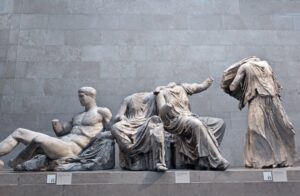
The British Museum in London is the world’s oldest national public museum, boasting a collection of at least 8 million artifacts. Of this vast collection, one of the most famous artworks on display are the ‘Elgin Marbles,’ a collection of Ancient Greek sculptures from the Parthenon and Acropolis of Athens. They were removed from Ottoman Greece between 1801 and 1812 and shipped to Britain by agents of Thomas Bruce, the 7th Earl of Elgin.
Fast-forward to today, Geoffrey Robertson, an Australian-British barrister and academic, calls the British Museum trustees “the world’s largest receivers of stolen property.” This brings to light a popular and controversial topic circulating in the contemporary world of international relations and law; Should Britain return its stolen artworks?
The case of the Elgin marbles is somewhat unique. In the early 19th century, Bruce claimed that he was given permission by the ruling Ottoman authorities to remove the sculptures and construct plaster molds. However, in doing so, he was persuaded to “save” the artifacts from destruction and defacement by sending the originals back to Britain.
The underlying motives for this move may likely have been linked to the ongoing political rivalry between the British and the French at the time. While Thomas Bruce sought to add to the British collection, the French were actively seeking out artifacts for their own “Musée Napoléon,” now known as the Louvre, the world’s largest museum.
The controversy as we know it today came long after Greece gained its independence and the Ottoman Empire fell. In the 1980s Greek Culture Minister Melina Mercouri set out to regain the marbles from the British Museum.
These efforts led to the construction of the Acropolis Museum which, according to its Swiss-French architect Bernard Tschumi, was “to convince the world the Elgin marbles should come back.”
In 2013 Greece took the case to the United Nations Educational, Scientific and Cultural Organization (UNESCO). In 2021, the UN body concluded that the UK government should return the sculptures and open negotiations with Greece. The UK government rejected this request.

Today, in 2024, you will find the Elgin Marbles lounging in Room 18 of the British Museum, where they have been for over 200 years.
This example is one of many that are linked to the controversy on whether the UK should return its foreign artifacts.
While the Elgin Marbles themselves were not taken as a result of colonialism, several of the items in the British Museum collection were taken or purchased in regions formerly under British colonial rule. Many of which are now independent nations, eager to acquire their stolen history.
Let us explore some of the arguments being made on both sides of this issue.
On one hand, these artifacts often hold cultural significance to their home countries and repatriation by the British would show respect to these nations in a positive show of diplomacy.
One could also argue that there is a moral aspect to this controversy. That the British are morally responsible for returning the artifacts in a symbolic gesture of recompense for the injustices of colonialism.
However, the British argue that the artifacts are legally theirs and would be “safer” if kept in London. A somewhat ironic point given that the museum discovered 1,800 items missing in 2023, a number that has since increased to at least 2,000 stolen in recent years.
Apart from these broader arguments, there is an added point to be made relating to the case of the Elgin Marbles. From a political perspective, Greece joined the EU in 1981 as its 10th member, only 8 years after the UK. This move brought Greece and the UK closer than ever with a shared single market and a level of political stability outlined in EU enlargement policy. This means that Greece at this point should have already been more than capable of ensuring the safety and care of its artifacts.
So what is the real reason behind the UK’s refusal to return its stolen artworks when the diplomatic benefits are so clearly positive? Is it money, pride, or maybe a fear that fulfilling one request would mean the loss of a much larger percentage of its collection down the line?
In all, while this controversy remains stagnant for the time being, it is fascinating to consider the role of art and crime in the global sphere. To think about its ties to politics and law and its potential to impact modern international relations and diplomacy.







